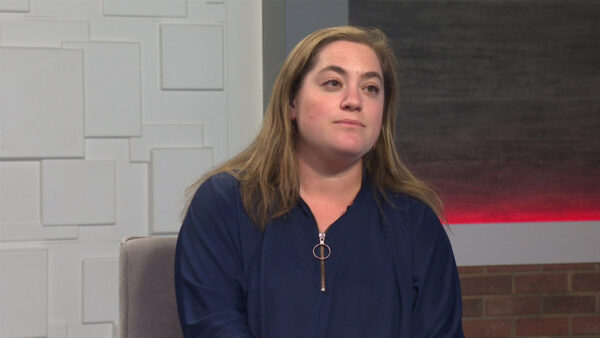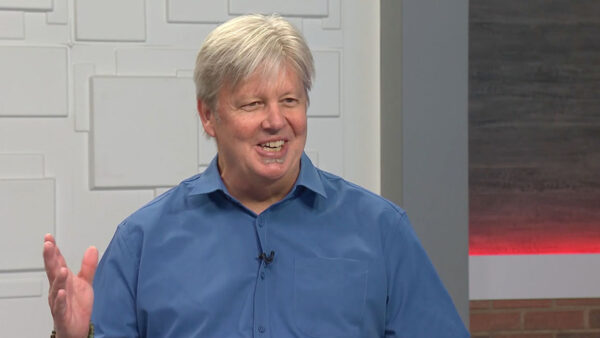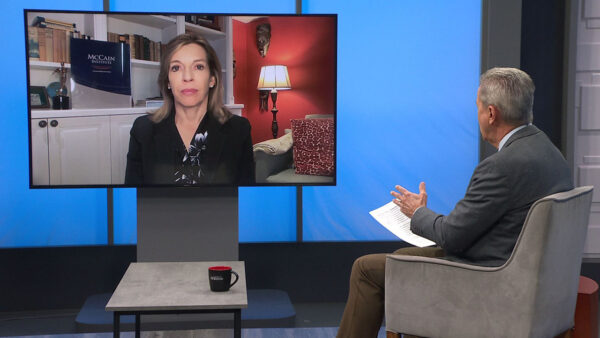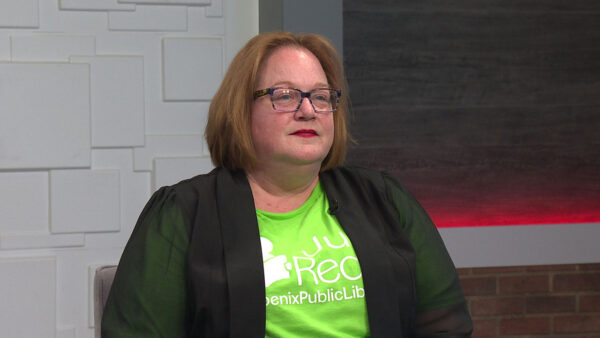Maricopa County Sheriff Joe Arpaio has been held in civil contempt of court, and a federal judge is expected to decide whether he should face criminal charges. Former U.S. Attorney for Arizona Paul Charlton, a managing partner at Steptoe and Johnson, will talk about what happens at the hearing.
Ted Simons: Coming up next on Arizona Horizon, Maricopa County Sheriff Joe Arpaio could be facing criminal charges. Also tonight, what do record low levels at Lake Mead mean for Arizona's water supply? And Tempe Town Lake is back in full operation after getting a new dam. Those stories next on Arizona Horizon.
Video: Arizona Horizon is made possible by contributions from the friends of Arizona PBS, members of your PBS station. Thank you.
Ted Simons: Good evening and welcome to Arizona Horizon. I'm Ted Simons. There are now 11 reported cases of measles in Arizona, and state health officials say there could be more than a dozen places in Maricopa and Pinal Counties where the public may have been exposed to the disease. The first cases were reported at the Eloy Federal Immigration Center, and exposure points have been found in Eloy, Casa Grande, and Coolidge. A federal judge today considered penalities and sanctions against Sheriff Joe Arpaio. This after the judge earlier 0:01:10:23 this month found Arpaio and three aides in civil contempt of federal court. Here to help explain what happened today is former US Attorney Paul Charlton, a managing partner of Steptoe and Johnson. Good to see you.
Paul Charlton: Thanks for having me.
Ted Simons: What happened in court today?
Paul Charlton: Well, we had arguments from all of the now many parties -- the Department of Justice, from the plaintiffs, who are represented by the ACLU, and certainly from Joe Arpaio's lawyers and the lawyers representing other members within Joe Arpaio's staff, all of whom are arguing for a vastly different set of remedies for this agreed-upon contempt of court.
Ted Simons: And so when you say remedies, we're thinking sanctions, we're thinking penalties. Any of those come out of today's hearing?
Paul Charlton: There were no decisions today. The judge made it clear in his most recent ruling that he wanted to hear oral argument, he wanted to read the pleadings that were submitted by the parties, and that he said soon thereafter he would make a decision on what the remedies would be.
Ted Simons: Have a lot of these ideas been banterred back and forth behind the scenes up until now?
Paul Charlton: They have been talked about considerably with the court, I suspect between the parties themselves. What is relatively new though is that the judge has put in writing that one of the alternatives available to the judge is a referral for a criminal prosecution, and the ACLU in their most recent pleadings indicated that they believe that criminal prosecution is the appropriate remedy here.
Ted Simons: And we keep hearing about criminal prosecution or referral thereof, is that going to happen? Didn't happen today. Is it going to happen soon?
Paul Charlton: We don't know. The judge said from would be a decision soon. There's a tell if you will if you play poker you would call this something you could look to and perhaps forecast the future. The judge used the word intentional many times. Intentional is the deciding point. It is the difference between whether someone has committed a civil violation or a criminal violation. If you do so intentionally the judge is more likely to find the criminal wrong here.
Ted Simons: Also notice the judge seemed to tell a couple of aides and personnel that they were basically off the hook. Didn't say the same thing for Arpaio and chief deputy.
Paul Charlton: That silence is damning. That means Joe Arpaio and chief deputy Sheridan will have to await the judge's decision as far as compensation to the victims it sounds like there was a compromise worked out.
Paul Charlton: Something like that. We know the judge is considering paying each of the victims, each of the individuals who was harmed by this profiling, $1,000 per hour and perhaps as much as $200 per quarter hour thereafter. There could be a considerable amount of money paid for by taxpayers as payment in penalties for these wrongs.
Ted Simons: the plaintiffs wanted more and the County wanted less. So the judge came up with the middle.
Paul Charlton: Not unusual for a judge in any case.
Ted Simons: the third basic point here that I thought was interesting was how best the judge has to figure out how best to return the sheriff department's internal affairs back to an operating level. The public and the judge can have some trust in. What happened at that end?
Paul Charlton: The judge suggested he would give his monitor greater control. That monitor has been reigned in if you will a bit, that the sheriff has had ultimate say-so on the penalties that will be imposed. The judge hinted today that perhaps he was going to take away that authority as to what punishment should be meted out for those deputies who fail to follow the judge's orders.
Ted Simons: he's hinting it would be an outside authority of some kind?
Paul Charlton: We already have a monitor in place, it will be greater authority to the monitor already there and striving to make sure Joe Arpaio stays in compliance with the judge's orders.
Ted Simons: the judge said something interesting along those lines. He said he had no confidence in the future of the sheriff's department. Yet he also said he hopes to rehabilitate internal affairs especially at the sheriff's department. What did you make of that?
Paul Charlton: An extraordinary finding in so many ways. Number one that a judge would find a head of a law enforcement may face criminal prosecution, that he has no faith in that agency but hopes that he can rehabilitate that. Fortunately in our country those are rare findings when they happen here they are findings worth paying close attention to.
Ted Simons: You mentioned as far as criminal proceedings two are off the hook. Not so Arpaio. Not so chief deputy Sheridan. Someone else was mentioned in court today.
Paul Charlton: this was another extraordinary finding by the judge, perhaps advisory decision. The judge told Michelle, Joe Arpaio's lawyer, she too should get a lawyer. Any time a judge tells a lawyer to hire his or her own lawyer, that is an unusual event and a bad day for that lawyer.
Ted Simons: I was going to say that suggests that there's more for her down the line.
Paul Charlton: That means that judge is worried that her own rights need to be protected by somebody else just as she was supposed to be doing for Joe Arpaio.
Ted Simons: was that the biggest surprise in the hearing today? What surprised you?
Paul Charlton: I suspect it is as a lawyer that decision that she should have her own lawyer but I don't think there are any other surprises because the judge set out in his last decision that today would be a decision just to hear arguments. Those arguments closely mirrored the written pleadings. Now the judge has the more difficult task of deciding what to do with Joe Arpaio and the sheriff's office as a whole.
Ted Simons: it sounds as if Joe Arpaio did not say anything today.
Paul Charlton: He has taken on that attitude that we rarely used to see and that is a silent Joe Arpaio.
Ted Simons: All right, so weeks?
Paul Charlton: Hard to predict. This has been a case going on for seven-some years. We'll have to see.
Ted Simons: would it surprise you more if there were a criminal referral or if there were not?
Paul Charlton: Because of the use of the word intent it would surprise me more if there were not a criminal referral here.
Ted Simons: all right. Good to see you. Thanks for joining us.
Paul Charlton: Nice to see you. Thank you. Basically still dropping as we speak, correct?
Ted Simons: The level was currently going down. It will recover a little just because of the way they operate lake Powell and lake Mead conjunctively.
Ted Simons: Monsoon will help a little bit?
Thomas Buschatzke: It potentially could help, yes, but it's for an operational issue between how they operate lake Powell and lake Mead.
Ted Simons: yet no water shortage declared for 2017. Why?
Thomas Buschatzke: So in 2007, the seven basin states and the Department of Interior entered into an agreement that created shortage triggers based on elevation of lake Mead and the elevation that triggers the first shortage is elevation 1075. But that would be the elevation 1075 on January 1 of any calendar year. So in August of this summer, the federal government will make a determination as to what the elevation of lake Mead will likely be January 1 of 2017. If it's above 1075 from will be no shortage and actually now the projection is that it will be 3.5 feet above that 1075 elevation.
Ted Simons: isn't there likelihood that by the ends of 2017, we're probably going to see something?
Thomas Buschatzke: So the probability of us being below 1075 the mathematical probability is over 50% in 2018.
Ted Simons: Okay. So that would mean Arizona would lose like 320,000 acre feet or something along those lines.
Thomas Buschatzke: so the first cut is 320,000 acre feet to the state of Arizona and 14,000 to Nevada and 13,000 to New Mexico. Because of old law from 1968 California doesn't take any cuts.
Ted Simons: Let's talk about that old law. It sounds like there's a three-state agreement between Arizona, Nevada and California in which oddly enough California is saying we'll go ahead and take a certain hit even though they don't have to. What's going on with that agreement?
Thomas Buschatzke: So that's an agreement that's still very much in process. Both in terms of agreement between the three states and also within the state of Arizona in terms of how the impacts fall on different water user groups. So we need to deliver an agreement internally in Arizona to share in the benefits of that agreement, share in some of the downsides, impacts of that agreement. As we continue to work with California and Nevada on closing the details of that agreement. Really what it is essentially is that Arizona would agree to take even larger shortage than a 320,000 acre feet at higher elevations of lake Mead in return for fro considerations California potentially taking less than their 4.4 million acre feet allocation.
Ted Simons: Sounds like California could lose up to 8% but we would lose 15% the first year.
Thomas Buschatzke: right now we would be below trigger point if the new agreement was to go into effect which we don't anticipate that really happening before January 1 of 2018 because of all the pieces that we have to put together including the department of water resources, the director going to the state legislature to get concurrent resolution passed that would allow me to sign on to the deal.
Ted Simons: That sounds like that would be quite the operation to get the legislature to agree to this. But the fact that California, which has first priority here, agrees to take a cut, any cut at all, would seem to help, would it not?
Thomas Buschatzke: I think it's a huge precedent for us to set with California. I think they are doing it for a variety of reasons. One, nobody wants either a judge or the secretary of interior to impose operations from lake Mead upon us. Also I think the flexibility that lake Mead gave California during their drought, their internal drought in the state water project going down to record low indications they need that flexibility in the future to take water that they stored in excess of the 4.4 out of Lake Mead to help backfill their shortages on their own state water projects.
Ted Simons: you referred to this earlier, the agreement as far as Arizona is concerned also kind of shares the costs. Agriculture always seems to be the first line of fire but sounds like you're working on a deal which across the board cuts will happen.
Thomas Buschatzke: I think we're working on a deal where we can share the benefits and share some of the detriments that are creating some of the impacts. Again, knowing that we need legislative approval there has to be equity among the stakeholders within Arizona in terms of how this new plan would impact them because I will need their support at the legislature to make sure that that resolution can pass through the legislature.
Ted Simons: do the other states need legislative support?
Thomas Buschatzke: They do not. We're the only one that has that statutory requirement. But they do have certain boards of irrigation districts in California, southern Nevada water authority obviously needs to approve the deal in Las Vegas on behalf of Nevada. There are approvals needed in the other states but they are not at the legislature.
Ted Simons: Just out of curiosity, how much Colorado River water is recharged in Arizona?
Thomas Buschatzke: So over the years, the Arizona water banking authority which specifically recharges water for Indian tribes and municipal and industrial customers of the central Arizona project has stored about 3.4 million acre feet of water. The total water usage in the state on an annual basis is 7 million acre feet. 40% of that comes from the Colorado River. 2.8 million acre feet.
Thomas Buschatzke: individual water providers, municipalities, et cetera, have stored another 5.5 million acre feet. In total we have about 9 million acre feet stored for Arizona. We have also stored for Nevada 600,000 acre feet. So about over 9.5 million acre feet. If you figure this is a high number an acre foot supports two families, that's 19 million people for a year.
Ted Simons: so when people hear about lake Mead falling and lowest levels ever and water shortages maybe by the end of 20 subpoena into 2018, when we looked at the fact that we could be 115 to 118 degrees by this weekend and the drought continues, the obvious thought is we are in a real water crisis here. Are we in a water crisis?
Thomas Buschatzke: So I don't know that it's ready for the level of crisis but certainly raised to the level we need to take action. The agreement that you referred to is one action but it's really building on actions we have taken to date. So we have seen this coming for a number of years. And the three states collectively, Nevada, Arizona and California, has about 3.5 -- sorry. Five feet in lake Mead artificially by conserving water. Another three feet stored. So we artificially kept eight feet of water in lake Mead. That is something that we have done to try to prop up the elevation to avoid hitting that shortage trigger and this agreement that we're working on will build on that concept. Again, hopefully to keep lake Mead from hitting that first shortage or hitting water deep shortages, larger shortages if the lake continues to fall.
Ted Simons: thanks for joining us.
Thomas Buschatzke: Thank you.
Video: Beside highway 191 near Clifton is a memorial to 1880s Arizona law and order. Then as now the Clifton cliff jail is a two-room hole. Blasted from solid rock, fitted with iron bars paid for by the owners of Clifton's first copper mine. Local tradition says the jail's first unwilling guest was the local stone mason hired to build it. When he finished the jail the mason decided to celebrate at Clifton's hoagie dance hall where he downed snake whiskey and shot up the place. It belonged to the deputy sheriff who rewarded him with a compulsory stay in his own creation. In 1906 a flash flood filled the ground level Bastille with water and mud, forcing rescue of prisoners by rope and the jail's closure. Today it's dry. Visitors are welcome to take an eerie step down and back into Arizona history.
Video: Get the inside Scoop on what's happening at Arizona PBS. Become an insider. You'll receive weekly updates on the most anticipated upcoming programs and events. Get the insider delivered to your email inbox. Visit AZPBS.org to sign up 0:19:13:04 today.
Ted Simons: Tempe Town Lake is back up and operational after being closed for a couple of months as a new steel and concrete dam was installed on the west end. We welcome Tempe Town Lake manager. Thanks for joining us. The Tempe Town Lake is back open, only filled?
Mark Mitchell: Only filled.
Ted Simons: what happened? Why was this process -- first of all, the new dam. Is this new dam up, operational, ready to go?
Mark Mitchell: Absolutely. Ready to go. Fit as a fiddle.
Ted Simons: what happened to the old dam?
Mark Mitchell: We had an agreement with Bridgestone. That was running out and they decided not to make the rubber bladders any more. We decided to find a more sensible solution, is which a steel gated dam. We worked with our staff and engineering and we have the largest steel gated dam system in the country here in Arizona.
Ted Simons: was this built on top of that or to the west of it?
Mark Mitchell: About 100 yards to the west of the rubber bladder. We had to take the rubber bladder out and restore it to operational. This is an opportunity to protect one of the greatest assets we have in our community.
Ted Simons: let's talk about this dam, hydraulically powered here.
Craig Caggiano: that's correct. The dam is made of steel gates. The steel gates are held up by hydraulics. Our dam is unique in that unlike dams that you think of when you think a dam holds back water to protect people downstream our dam holds back water to create the lake and downstream is just a river. Our dam is made in a safety manner so that when we need to release it we can regardless of whether there's power or not power. Hydraulics holds the dam up.
Ted Simons: this would be in case of, what, floods?
Craig Caggiano: Sure.
Ted Simons: The dam needs to go down, so as we have seen in this video, this is what's happening, right? Basically going down and here comes the water.
Craig Caggiano: that's correct. It's not so much floods but just natural flow of the river. The river has very large capacity as you can see by its channel. Most people don't realize the Salt River is channelized, made to hold a flow that runs across that entire channel. So what we can do with the dam is we can let out some water and we can accommodate that flow.
Ted Simons: So someone is in charge of this? Is there an operate -- a control room?
Craig Caggiano: there is. Yes. But it's a little more complicated in that our dam is able to operate automatically. It can actually sense the level of the lake and make adjustments as inflows come into the lake to keep it at the same level.
Ted Simons: Mayor, how long is this supposed last? The last one was supposed last a long time.
Mark Mitchell: it was. This one we have been told, I'm pretty sure it's accurate, will last at least 50 years. Great technology for us.
Ted Simons: as far as the closure of -- how long was the lake closed?
Mark Mitchell: Closed I think three months.
Ted Simons: That was it?
Mark Mitchell: very short.
Ted Simons: seemed longer. Economic impact of just closing the lake for that long.
Mark Mitchell: Well, look at the flip side. Since the inception the lake has generated $1.4 million of capital investment in and around the lake. We currently have 40,000 people that work around the lake and 10,000 that live around the lake. Just the cost of the lake the replacement dam, Tempe center for the arts, arena, the total cost has been about $315 million. I think our return on investment is unique.
Ted Simons: When it was closed can you put a price tag -- what would it cost for boat rentals --
Mark Mitchell: We're preserving an asset and maintaining it for future generations. This weekend I know it was really busy down Tempe Town Lake. My daughter was paddle boarding this weekend as a lot of people were. It's a highly used lake. We just made sure that by having this new dam system it's going to protect an asset, an amenity for generations to come.
Ted Simons: That bridge back open?
Mark Mitchell: It's back open. I just saw on social media someone proposed will you marry me, they wrote it in sidewalk on the sidewalk on the bridge.
Ted Simons: they defaced it --
Mark Mitchell: It's washes away.
Ted Simons: As far as -- 1.2 million goldfish were put into the lake to fight flies?
Craig Caggiano: the lake is a lake. An eco-system. In order to fuel that eco-system we added goldfish. Goldfish and a couple other species were added at one time in a massive amount to get that eco-system back into gear. We like to operate it efficiently and ecologically. The goldfish provide the benefit of keeping down mosquito and Midge larva. Midge are the little flies that are a nuisance. Goldfish eat those and become part of the food chain and get eaten by larger fish.
Ted Simons: Didn't I hear there are bigger fish introduced in the lake even earlier?
Craig Caggiano: There were. There are fish being introduced in the lake all times by Arizona game and fish. They just recently did stocking on crappy and they will do it again soon.
Ted Simons: if you're a little fish watch out for the big fish.
Craig Caggiano: exactly.
Ted Simons: we just talked about water resources in Arizona. We're not at crisis level but close. Critics will say the lake is not a wise use of water for Arizona. You've heard that criticism. How do you respond?
Mark Mitchell: Well, water is a precious asset for us. We know that. So much so we conserve water regularly with toilets, shower heads, more importantly we only use about equivalent of two golf courses a year for water in Tempe Town Lake. Because of the tourism draw sur plants a lot of that. We offer sustainability goals. Really helps negate some of that.
Ted Simons: we have to stop it there. Congratulations on getting it back open.
Mark Mitchell: Thank you.
Ted Simons: Appreciate you coming on.
Craig Caggiano: Thank you.
Ted Simons: And that is it for now. I'm Ted Simons. Thank you so much for joining us. You have a great evening.
Video: "Arizona Horizon" is made possible by contributions from the friends of Arizona PBS, members of your PBS station. Thank you.
Paul Charlton: Former U.S. Attorney for Arizona























